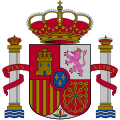安达卢斯

| 安达卢斯历史 |
|---|
 |
| 泰法诸国第一阶段(1009年-1110年) |
| 泰法诸国第二阶段(1140年-1203年) |
| 泰法诸国第三阶段(1232年-1287年) |
|
伊比利亚半岛 收复失地运动 |
| 西班牙历史 |
|---|
 |
| 历史系列条目 |
| 年表 |
|
|
| 葡萄牙历史 |
|---|
 |
| 历史系列条目 |
| 葡萄牙历史年表 |
安达卢斯(阿拉伯语:الأندلس;Al-Andalus)是穆斯林在中世纪对伊比利亚半岛的称呼。 [1]全盛时期包括大部分伊比利亚半岛[2]和今天南法的塞蒂马尼亚。这词语也指半岛被阿拉伯和柏柏尔政权(西方称摩尔人)统治的711年-1492年这段时期,而基督教王国收复失地运动的进程亦不断改变这一地域的界线,[3][4][5]结果它萎缩到南部并最终只指小小的格拉纳达酋长国。今天西班牙南部的安达卢西亚因此得名。
安达卢斯的范围于711年伍麦叶王朝刚刚征服西班牙后达到全盛。在倭马亚王朝统治时期,安达卢斯被划分为五个行政区,对应今天的安达卢西亚;葡萄牙与加利西亚;卡斯蒂利亞与莱昂;纳瓦拉、阿拉贡与加泰罗尼亚;以及奥克西塔尼大区的朗格多克-鲁西永。 [6]政治上,它相继作为倭马亚王朝、科尔多瓦酋长国、后倭马亚王朝和西班牙地区诸“泰法”王国的政区。各国的统治促进了穆斯林与基督徒的文化交流和协作。 基督徒和犹太人要向穆斯林王国提交额外的人头税,以获得信仰自由和同等保护。
在后倭马亚王朝的经营下,安达卢斯成为了学术的灯塔,而首府科尔多瓦还成为了全地中海盆地、欧洲和伊斯兰世界最顶尖的经济及文化中心之一,兼欧洲最大城市。许多先进的伊斯兰和西方科学来自安达卢斯,例如伊本·弗纳斯(Ibn Firnas)发明的第一款滑翔机,三角学、天文学、手术、药剂、农业学的其他成就,以及伊本·鲁世德的杰作。安达卢斯成为欧洲和地中海沿岸地区的主要教育中心,并成为伊斯兰世界和基督教世界之间进行文化和科学交流的渠道。 [7]
在历史上的大部分时间,安达卢斯一直与北方的基督教王国起冲突。后倭马亚王朝灭亡后,安达卢斯分裂出多个小国。而基督教王国的攻势亦日益凌厉,以卡斯蒂利亞为主。 穆拉比特王朝介入并挡住了基督教阵营的攻势,废除了一些较弱的安达卢斯亲王国,以及建立了柏柏尔人对安达卢斯的直接统治。在后一个半世纪,安达卢斯受到了都城位于马拉喀什的柏柏尔帝国,穆拉比特王朝与穆瓦希德王朝的统治。
最终,北方的基督教王国压过了南部的伊斯兰国家,向南推进。 1085年,阿方索六世攻下了托莱多,开始了伊斯兰势力的衰落。随着1236年科尔多瓦的陷落,南部大部分地方已经落到基督教王国手上,格拉纳达酋长国两年以后也成为了卡斯蒂利亞王国的附庸。 1249年,葡萄牙的收复失地运动以征服阿尔加维作结,使格拉纳达酋长国成为半岛仅存的伊斯兰国家。最后,在1492年1月2日,[8]格拉纳达伊玛目穆罕默德十二世向卡斯蒂利亞女王伊莎贝拉一世投降,基督教王国的收复失地运动完成。
词源
[编辑]“安达卢斯”(الأندلس)一词最早可见于716年新穆斯林政府在西班牙铸造的硬币。 [9]这些硬币(称为第纳尔)同时具有拉丁文和阿拉伯文。 [10][11]传统认为“安达卢斯”由汪达尔人的名称转写而成,但20世纪80年代以来的提议挑战了这一传统。 [12]有人提出它从阿特兰蒂斯一词演变成,[13]有人提出它源自哥特语词语“*landahlauts”,[14]甚至有人提出它的源头早于罗马时代以前。 [15]
历史
[编辑]伍麦叶时期
[编辑]伍麦叶哈里发瓦利德一世统治时期,穆斯林将军齐亚德带领一众柏柏尔人于711年登陆于今直布罗陀地区,并且在瓜达莱特战争中击败以篡位上任的西哥特国王罗德里克。之后,齐亚德将军在获得马格里布总督努塞尔的军事援助后便往北征服,并且在717年时跨越比利牛斯山征服塞普提曼尼亚。
脚注
[编辑]- ^ Camilo Gómez-Rivas. Law and the Islamization of Morocco under the Almoravids: The Fatwās of Ibn Rushd al-Jadd to the Far Maghrib. Brill. 21 November 2014: 1, note 3 [2020-04-25]. ISBN 978-90-04-27984-1. (原始内容存档于2021-01-16).
- ^ Fernando Luis Corral. The Christian Frontier against al-Andalus (Muslim Spain): concept and politics during the reigns of King Fernando I of Castile and Leon and his successors until 1230. Natalie Fryde; Dirk Reitz (编). Walls, Ramparts, and Lines of Demarcation: Selected Studies from Antiquity to Modern Times. LIT Verlag Münster. 2009: 67 [2020-04-25]. ISBN 978-3-8258-9478-8. (原始内容存档于2021-01-16).
- ^ "Para los autores árabes medievales, el término al-Andalus designa la totalidad de las zonas conquistadas - siquiera temporalmente - por tropas arabo-musulmanas en territorios actualmente pertenecientes a Portugal, Espana y Francia" ("For the medieval Arab authors, al-Andalus designates all the conquered areas - even temporarily - by Arab-Muslim troops in territories now belonging to Portugal, Spain and France"), José Ángel García de Cortázar, V Semana de Estudios Medievales: Nájera, 1 al 5 de agosto de 1994, Gobierno de La Rioja, Instituto de Estudios Riojanos, 1995, p.52.
- ^ "Los arabes y musulmanes de la Edad Media aplicaron el nombre de al-andalus a todas aquellas tierras que habian formado parte del reino visigodo : la Peninsula Ibérica y la Septimania ultrapirenaica." ("The Arabs and Muslims from the Middle Ages used t he name of al-Andalus to all those lands that were formerly part of the Visigothic kingdom: the Iberian Peninsula and Septimania"), Eloy Benito Ruano, Tópicos y realidades de la Edad Media, Real Academia de la Historia, 2000, p.79.
- ^ "Andalus, al-" Oxford Dictionary of Islam. John L. Esposito, Ed. Oxford University Press. 2003. Oxford Reference Online. Oxford University Press. Accessed 12 June 2006.
- ^ O'Callaghan, Joseph F. A History of Medieval Spain. Ithaca: Cornell University Press. 1983-10-31: 142 [2020-04-23]. ISBN 0801468728. OCLC 907117391. (原始内容存档于2021-01-16).
- ^ Covington, Richard. Arndt, Robert , 编. Rediscovering Arabic Science. Saudi Aramco World (Aramco Services Company). 2007, 58 (3): 2–16 [2020-04-23]. (原始内容存档于2021-03-01).
- ^ Pigna, Felipe. La Reconquista española. El Historiador. 2018-02-06 [2020-04-25]. (原始内容存档于2015-12-08) (西班牙语).
- ^ Sabine Panzram; Laurent Callegarin. Entre civitas y madina: El mundo de las ciudades en la península ibérica y en el norte de África (siglos IV-IX). Casa de Velázquez. 22 November 2018: 145 [2020-04-22]. ISBN 978-84-9096-227-5. (原始内容存档于2021-01-16).
- ^ Michael L. Bates. The Islamic Coinage of Spain. Jerrilynn D. Dodds (编). Al-Andalus: The Art of Islamic Spain. Metropolitan Museum of Art. 1992: 384 [2020-04-22]. ISBN 978-0-87099-636-8. (原始内容存档于2021-01-16).
- ^ Thomas F. Glick. Islamic And Christian Spain in the Early Middle Ages. BRILL. 2005: 21 [2020-04-22]. ISBN 90-04-14771-3. (原始内容存档于2021-01-16).
- ^ Cantó, Pablo. De dónde vienen los nombres de las Comunidades Autónomas españolas. El País (Prisa). 9 September 2016 [15 April 2019]. (原始内容存档于2021-03-08) (西班牙语).
- ^ Joaquín Vallvé. La división territorial de la España musulmana. Instituto de Filología. 1986: 55–59 [2020-04-22]. ISBN 978-84-00-06295-8. (原始内容存档于2021-01-16).
- ^ Halm, H einz. Al-Andalus und Gothica Sors. Der Islam. 1989, 66 (2): 252–263. doi:10.1515/islm.1989.66.2.252.
- ^ Bossong, Georg. Restle, David; Zaefferer, Dietmar , 编. Der Name al-Andalus: neue Überlegungen zu einem alten Problem [The Name al-Andalus: Revisiting an Old Problem] (PDF). Trends in Linguistics. Studies and Monographs. Sounds and systems: studies in structure and change. (Berlin: De Gruyter Mouton). 2002, 141: 149 [2020-04-22]. ISBN 978-3-11-089465-3. ISSN 1861-4302. (原始内容存档 (PDF)于2008-06-27) (德语).
Only a few years after the Islamic conquest of Spain, Al-Andalus appears in coin inscriptions as the Arabic equivalent of Hispania. The traditionally held view that the etymology of this name has to do with the Vandals is shown to have no serious foundation. The phonetic, morphosyntactic, and historical problems connected with this etymology are too numerous. Mo reover, the existence of this name in various parts of central and northern Spain proves that Al-Andalus cannot be derived from this Germanic tribe. It was the original name of the Punta Marroquí cape near Tarifa; very soon, it became generalized to designate the whole Peninsula. Undoubtedly, the name is of Pre-Indo-European origin. The parts of this compound (anda and luz) are frequent in the indigenous toponymy of the Iberian Peninsula.
